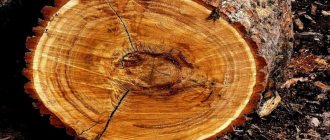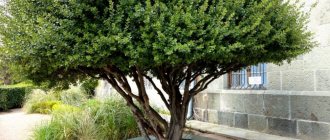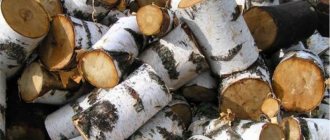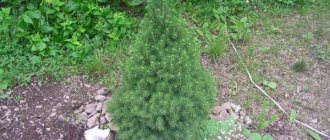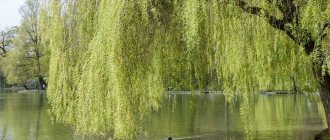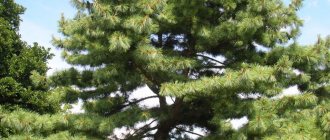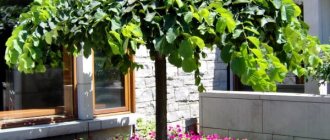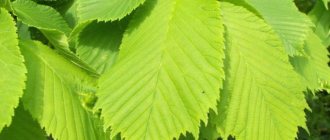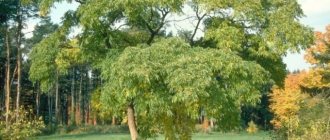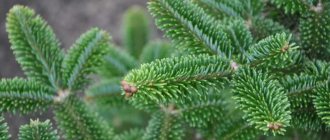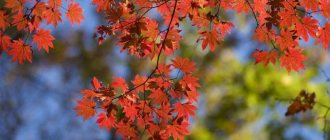These long-lived deciduous and evergreen trees are very diverse in foliage structure, overall size and habit. All of them form acorns - ovoid fruits-nuts, the base of which is immersed in a cup-shaped plus - an extension of the stalk, covered with budding, sometimes fringed scales. Oak trees have a spreading crown and a deep, extensive root system, so they are not suitable for a small area. The trees discussed below are more or less cold-resistant, although this indicator greatly depends on the species. Winter temperatures are of course important. However, much more damage is caused by spring frosts, which damage the opened buds. As a result, in some regions oaks, instead of slender trees, grow in the form of twisted bushes.
Oak
Trees of central Russia. Oak.
English oak, or summer oak
, or
common oak
(lat.
Quércus róbur
) is the type species of the genus Oak (
Quercus
) of the Beech family (
Fagaceae
); a large tree reaching a height of 30-40 m, forming broad-leaved forests (oak groves) in the southern forest and forest-steppe zones.
- Kingdom: Plants
- Department: Flowers
- Class: Dicotyledons
- Order: Beeceae
- Family: Beech
- Genus: Oak
- Type: English oak
A large, usually strongly branching tree with a huge crown and a powerful trunk. Reaches a height of 20-40 m. It can live up to 2000 years, but usually lives 300-400 years. Growth in height stops at the age of 100-200 years; growth in thickness, although insignificant, continues throughout life.
Oak root system
The root system consists of a very long tap root; from six to eight years of age, lateral roots begin to develop, also going deep into the ground.
The crown is dense, tent-like or wide-pyramidal, asymmetrical, spreading, with strong branches and a thick trunk (up to 3 m in diameter). In young trees, the trunk is irregular, geniculate, and with age it becomes straight and cylindrical. In closed plantings, the crowns are smaller and the trunks are more slender (up to 1 m in diameter).
The bark is dark gray, blackish, thick. Young oak trees have gray, smooth bark. In the 20th-30th year, more or less deep cracks form on the bark. Trees grown in freedom have bark up to 10 cm thick.
Young shoots are fluffy, brown or reddish-gray, shiny, with brown spots and slightly oblong lenticels.
The buds are obtusely pentagonal, 5 mm long and 4 mm wide, the lateral ones are slightly smaller and spaced apart, the scales are numerous, five-rowed, rounded, brown, glabrous and ciliated only along the edge. All buds are usually ovoid, almost spherical, light brown, rounded or bluntly pointed at the apex, leaf scar with 7-15 marks. The apical buds are surrounded for the most part by several lateral ones.
The leaf arrangement is alternate, at the top of the branches in the form of bunches. The leaves are oblong, oblong-obovate, narrowed downward or heart-shaped, often with ears, obtuse or notched at the apex, pinnately lobed, large (40-150 mm long, 25-70 mm wide), with four to seven lobes, hard, almost leathery, dark green above, shiny, yellowish or green below, with very prominent lighter veins, bare on both sides, with short petioles up to 10 mm long, always falling off in winter. The blades are blunt, rounded, the notches between them are shallow.
Oak flowers
Flowers are dioecious. Flowering begins in trees between 40 and 60 years old, along with the blossoming of leaves, usually in May. The plant is monoecious. Staminate flowers are collected in long pendulous catkins 20-30 mm long, with ten or more flowers, two or three together or singly on the tops of last year's shoots or in the lower part of young shoots. Each flower sits far from the other, so a peduncle is clearly visible between them, has a five- or seven-parted, fringed, membranous, greenish perianth at the edges, as well as five or six or more (up to 12) stamens with short filaments and large yellow anthers. Female flowers are usually located on young shoots higher than male ones, collected in small groups of two or three together on a separate reddish stalk, have a six-parted, reddish perianth at the edges, surrounded by hairy green scales with reddish apex, representing the future plus. The ovary is three-lobed, red, the stigma is thread-like, slightly protruding outward. Nests in the ovary are formed only after pollination, three in number, with two eggs in each. Each ovary usually develops only one acorn. Acorns hang in pairs, rarely one to five on a stalk up to 80 mm long.
Acorn
Oak fruits
The fruit is a nut (acorn) bare, brownish-brown (1.5-3.5 cm long and 1.2-2 cm in diameter), on a long (3-8 cm) stalk. The acorn is placed in a saucer or cup-shaped bowl - plus (0.5-1 cm long). The fruits ripen in September - October.
There are two known forms of common oak - early and late. The leaves of the early one (“summer oak”) bloom in April–May and fall off for the winter, while the leaves of the late one (“winter oak”) bloom two to four weeks later. At the same time as the leaves bloom, the oak blossoms. Wind pollinated. The leaves fall later than many other trees, at the end of September - October. On young winter oak plants, the leaves turn brown in the fall, but sometimes remain on the tree throughout the winter.
Rules for preparing a planting pit for better growth of seedlings
Every gardener asks the question: how to replant an oak tree to speed up growth and get a strong tree? A properly selected location and a fertilized planting pit play an essential role in obtaining a good result.
The hole preparation process occurs in the following sequence:
- We mark the area meter by meter and dig a hole 80 cm deep.
- We remove the top fertile layer of soil and save it.
- We throw out the soil located deeper than 30 cm.
- We fill the bottom of the planting hole with crushed stone or pebbles to a depth of 15-20 centimeters.
- Preparing a nutrient substrate for the seedling. Mix the deposited layer of humus with humus. It is enough to add 2 buckets. Then mix the contents with a kilogram of ash. To protect against pests, add 1.5 kg of lime to the mixture. We add mineral fertilizers according to the instructions on the packages. Divide the resulting composition into 2 equal parts.
- Fill the hole with 12 parts of the mixture.
- We install the seedling, distribute the roots of the plant, and fill it with the remaining nutrient substrate. The root collar should protrude about 3 cm from the soil.
- The soil is compacted so that there are no air pockets left.
- Gradually pour out 10 liters of settled water. Excess liquid will drain through the crushed stone drainage system.
- We mulch the space around the tree with peat and wood chips.
How fast does oak tree grow? The first few years the shoot grows quickly, forms branches and becomes covered with leaves. Then growth slows down. It takes 30-50 years for a tree to fully form.
Oak plant: photos, types, cultivation, planting and care in open ground
These long-lived deciduous and evergreen trees are very diverse in foliage structure, overall size and habit. All of them form acorns - ovoid fruits-nuts, the base of which is immersed in a cup-shaped plus - an extension of the stalk, covered with budding, sometimes fringed scales. Oak trees have a spreading crown and a deep, extensive root system, so they are not suitable for a small area. The trees discussed below are more or less cold-resistant, although this indicator greatly depends on the species. Winter temperatures are of course important. However, much more damage is caused by spring frosts, which damage the opened buds. As a result, in some regions oaks, instead of slender trees, grow in the form of twisted bushes.
Oak
Choosing a suitable place to plant a tree
So that the seedling quickly takes root in a new place and turns into a mighty oak tree. It is necessary to correctly determine the location of the future landing.
If you follow the recommendations below, you can grow a tree with a luxurious crown without undesirable consequences for the site.
The place must be free. The distance from the seedling to other trees must be at least 3 m. The distance from buildings is from 3.5 m.
As soon as the tree thoroughly takes its place, the root system will become capable of destroying garden paths, the integrity of the foundation of fences and houses, and communications.
Of all the variety of varieties, only holm oak has the ability to grow in shady areas. The remaining sprouts love sunlight.
It is ideal to place them in the southwestern part of the garden. It is unacceptable to plant them near other trees or on the shady side of the site. The plant will be weak.
Oak is an unpretentious plant, but very young oaks prefer fertile soil.
The planting hole is prepared in advance, fertilizing it with special compounds or soil from the parent site (the shoot germination environment). The soil should be kept neutral in acidity.
Almost all oak trees easily tolerate drought and suffer if there is prolonged stagnation of water at the roots. The tree should not be planted in lowlands.
Recommended species and varieties
Q. borealis
The crown is spherical. Leaves fall only in the harshest winters. Their plates are obovate, with rounded lobes, 12.5 cm long. The bark cracks with age and becomes brownish-gray. A heat-loving species that in Russia can be cultivated in the south of the Krasnodar Territory. The height and diameter of the plant is 8x5 m (20 years). Maximum height - 30 m.
Heat-loving species
Q. castaneifolia "Greenspire"
The crown is narrow. The leaves that fall in winter are glossy, oblong or oval, with rough triangular teeth along the edge, about 18 cm long. The height and diameter of the plant is 14x5 m (20 years). Maximum height - 30 m.
Leaves are glossy
Q. coccinea
The dark green leaves turn scarlet in the fall and fall off. Their plate is 15 cm long, with pointed lobes. The silvery-gray-brown bark remains smooth for many years. Homeland - eastern USA and South-East. Canada. In Europe, acorns are rarely produced. Resistant down to -30°C. The height and diameter of the plant is 10x8 m (20 years). Maximum height - 25 m.
Dark green leaves
"Splendens"
The autumn color of the leaves of this variety is especially attractive.
"Splendens"
Q.frainetto (D. hungarian)
The leaves are deciduous, leathery, multi-lobed, up to 18 cm long. Their blades are narrow at the base and widest at the apex. Homeland - E. Europe. Withstands down to -20°C, and is therefore recommended for the southern regions of Russia. The height and diameter of the plant is 8x5 m (20 years). Maximum height is 30 m.
Leaves falling, leathery
Q. ilex (D. stone)
An evergreen tree with a spherical crown and dark gray crackling bark. The leaves are up to 6 cm long, leathery, glossy, dark green above and gray below, sometimes with sparse sharp teeth. After a particularly hot summer, small and green, but viable acorns are formed. Despite its relative cold resistance, this oak feels best in a mild coastal climate. Homeland - Chile. This heat-loving subtropical species can only be grown on the Black Sea coast. The height and diameter of the plant is 6x5 m (20 years). Maximum height - 25 m.
Evergreen tree with a spherical crown
Application
When growing oak, gardeners involuntarily think about where this tree is used. Culture is actively used in various areas of human life. Almost all parts of the crop are used as material, including roots, leaves and wood. Plants not only provide decoration for gardens and parks, but are also used in farming and construction.
At home
Oak wood is considered one of the strongest and most durable, therefore it is actively used in the construction industry. The construction of oak furniture brings great profits, since it is one of the most valuable materials. The powerful trunks of young oak trees are used in the construction of houses.
Acorn nuts are also used in everyday life because they contain an abundance of starch and tannins. Acorns are used to feed livestock, especially pigs. In some plant species, the fruits are suitable for human consumption. In some countries, coffee is made from acorns.
Oak is considered one of the most active plants participating in the symbiosis of truffle mushrooms. Therefore, the crop is often used to grow one of the most expensive dishes in Europe.
In medicine
Oak bark is actively used in medicine because it has many beneficial properties. Tanning compounds allow you to solve problems such as:
- stomatitis and other inflammations of the oral cavity;
- diarrhea;
- mushroom poisoning;
- menstrual irregularities;
- inflammation of the liver and spleen;
- dysentery;
- haemorrhoids;
- nocturnal enuresis;
- eczema and other rashes on the body.
This abundance of diagnoses for which oak helps is due to the large number of beneficial properties of the plant. Oak has a great effect on relieving inflammation. Even a small amount of oak-based product can eliminate inflammation. In addition, oak has a pronounced diaphoretic, astringent, and antimicrobial effect. It has been proven that the plant has a disinfecting effect.
In folk medicine
In folk medicine, oak is considered one of the most valuable medicines, on the basis of which many recipes are prepared. Various diseases can be cured with infusion or decoction of oak bark or fruits, but remember that the remedies do not replace traditional medicine.
Recipes
- To treat inflammation of the oral cavity, prepare a decoction consisting of half a glass of boiling water and 5 g of dried crushed bark. The mixture is boiled for several minutes, then cooled and used to rinse the mouth.
- To prevent excessive sweating of the feet, use the following recipe: a decoction of oak bark, prepared from half a liter of water and 4 tablespoons of crushed medicinal raw materials, is brought to a boil and removed from the heat. The resulting mixture is used as a foot bath. The procedure is carried out daily throughout the month.
- To treat enterocolitis, prepare an infusion of acorns - dry crushed nuts are mixed with a glass of boiling water, adding 1 teaspoon to the liquid. The infusion is cooled, filtered and taken orally, half a glass three times a day. The product is also effective in the treatment of female cycle disorders and cystitis.
- Infusion of bark for diarrhea - 1 teaspoon of the crushed mixture is poured with half a liter of hot water and the mixture is allowed to brew for 6-8 hours. The mixture is filtered and taken warm, half a glass three times a day.
- Decoction lotions help fight purulent skin rashes. To do this, lotions from the decoction are applied to the affected areas of the skin.
- An infusion of oak bark, prepared from a glass of boiling water and a tablespoon of a medicinal mixture, infused for half an hour, helps with inflammation of the female genital organs. To do this, douching or rinsing, taking the drug orally.
Contraindications
Oak-based medicines have a fairly pronounced healing effect, so taking them without a doctor’s advice is dangerous. Although the plant is safe, it should not be used if you have allergies. In addition, the broth should not get into the eyes.
In landscape design
Oak trees are often found in park areas of urban areas. The plant is quite compact in size and unpretentious, and can also decorate a large space at once. Mighty plants remain decorative throughout the season. When planted alone, these are plants with thick trunks and a spreading dome-like crown. At the same time, by planting several oak trees nearby, straight and slender beauties with a lush and luxurious crown grow.
Interesting Facts
- Many people claim that acorns are nuts, but in fact they are single-seeded capsules.
- During strong winds, female flowers are easily held on the stem, while male flowers are weakly attached and fall off.
- Some oak acorns are used to make flour.
- There are oak trees with evergreen leaves.
- The bark is used to make stoppers for wine bottles and champagne.
- Oak wood is the only material from which barrels for storing wine are made.
- Only a few species of oak trees grow in the Southern Hemisphere.
Oak is a mighty tree capable of preserving the history of mankind. The plant has an abundance of species, but only a few dozen of them are grown. This culture is easily propagated at almost any time of the year, and is also used in many areas of human activity. The article helps with the question of how to properly grow a healthy tree on your site, as well as where it is better to plant an oak tree on your site and how to care for it.
Alphabetical index of plants
Examples of landscape projects from our studio
Landscape design and design services
Decorative groups of trees and shrubs are an integral part of the garden landscape design. Plants of various types, shapes and colors, collected in a separate landscape composition, form a single harmonious whole in the group and look different, but equally beautiful from different parts of the garden plot, as well as at different times of the year. What knowledge does a designer need when designing and composing a decorative group of plants?
Notes
- For the convention of indicating the class of dicotyledons as a superior taxon for the group of plants described in this article, see the section “APG Systems” of the article “Dicotyledons”.
- PiterSad.ru Red oak
- Quercus rubra
: information about the taxon in the Plantarium Project (a plant key and illustrated species atlas). - OAK (Quercus) Archived copy dated June 2, 2009 on the Wayback Machine // Rodniki.bel.ru
- Firsov, G. A.
Invasive potential of Quercus rubra L. in St. Petersburg: Art. / G. A. Firsov, K. G. Tkachenko, N. V. Lavrentiev // Bulletin of the Udmurt University. Series “Biology. Earth Sciences": scientific. journal.. - Izhevsk: Federal State Budgetary Educational Institution of Higher Professional Education "Udmurt State University", 2022. - T. 27, issue. 3, Botanical research. - pp. 297-305. — UDC 581.524.2:582.632.2 (470.23-25)(G). — ISSN 2412-9518. - BBC series: The Life of Mammals. Episode 4. Rodents (unspecified)
(inaccessible link). Access date: September 2, 2012. Archived August 3, 2012.
Morphological analysis of auxiliary parts of speech
There are no non-constant features in auxiliary parts of speech. During parsing, only constants are determined.
For prepositions:
For unions:
For particles:
Parsing example
The old tree would have grown near the house for a long time, but the unexpected happened.
Simple, derivative; does not change. Not a member of the proposal.
Simple, imaginative; does not change. Not a member of the proposal.
Shape-forming; does not change. Not a member of the proposal.
Adviсe
Derivative prepositions should be distinguished from adverbs. This is not difficult to do. Need to remember:
Example: I looked around (adverb). / He ran around the house (preposition).
Wood
Red oak sapwood ranges from white to light brown in color; the heartwood is a pinkish, red-brown color. In appearance, red oak is similar to white oak, the difference lies in less pronounced patterns due to shorter rays. The wood has a straight grain and a rough structure. The dry density of red oak wood is 790 kg/m³.
Red oak wood can be machined and is highly polished.
Application
Production of lumber, veneer, furniture production, flooring production.
| From left to right: mature tree bark; young tree bark; leaves; trunk in section |
Sort the adjectives into groups?
Sort the adjectives into groups.
There are 3 groups of qualitative relative and possessive adjectives.
Distribute these phrases into these 3 groups.
Strawberry jam, mother's hat, children's toys, a touchy child, a silver spoon, a wolf's trail, a mouse hole, a strong wind, a fur coat, a proud man, a tracksuit, a bright light, an ugly act, a dog's tail, grandma's house, a wooden handle.
PLEASE HELP I REALLY NEED IT!
PLEASE NEED IT URGENTLY.
